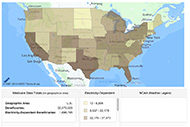FCC approves devices on health care spectrum
TECHNOLOGY // The Federal Communications Commission (FCC) on Aug. 6 approved rules to permit unlicensed devices to operate on the same channel as the Wireless Medical Telemetry Service (WMTS) used by hospitals for patient monitoring devices. While the commission provided a mechanism for increasing the size of the adopted protection zones on a hospital-by-hospital basis, the American Hospital Association (AHA) expressed concern that the rules will not adequately protect many WMTS systems from interference by these unlicensed devices. “We remain highly concerned that if the rules adopted today are left unchanged, patient safety could be compromised,” AHA Executive Vice President Rick Pollack said at press time. “We will continue to work with Congress, the FCC and device developers to seek a remedy that puts patients first.” The AHA had urged the FCC to delay the rules for at least three months to allow stakeholders to develop a cooperative, consensus resolution.
FDA issues alert on infusion pump cybersecurity
BIOMEDICAL // The Food and Drug Administration (FDA) has alerted health care facilities to cybersecurity vulnerabilities with an infusion pump used for continuous delivery of general infusion therapy. According to the FDA, Hospira and an independent researcher confirmed that the Symbiq Infusion System could be accessed remotely through a hospital network, which could allow an unauthorized user to control the device and change the dosage the pump delivers. The agency is not aware of any adverse events or unauthorized access of the system in a health care setting, but strongly encourages facilities to transition to alternative infusion systems as soon as possible. In May, the FDA issued recommendations to reduce the risk of security vulnerabilities identified in two other infusion pumps made by Hospira.
OSHA issues instructions on HazCom standard
SAFETY // The Occupational Safety and Health Administration (OSHA) recently issued instructions to compliance, safety and health officers on how to ensure consistent enforcement of the revised Hazard Communication standard. OSHA revised the Hazard Communication standard in March 2012 to align with the United Nations Globally Harmonized System of Classification and Labelling of Chemicals. This instruction outlines the revisions, including the revised hazard classification of chemicals, standardizing label elements for containers of hazardous chemicals and specifying the format and required content for safety data sheets. It explains how the revised standard is to be enforced during its transition period and after the standard is fully implemented on June 1, 2016. Under the standard, employers have been required to train workers on the new label elements and safety data sheets since Dec. 1, 2013.
FDA issues duodenoscope reprocessing guidance
CENTRAL SERVICES // The Food and Drug Administration (FDA) has released guidance on supplemental reprocessing measures that may reduce further the risk of infection associated with the use of duodenoscopes. The measures, which emerged from an FDA-led expert panel meeting, are intended to supplement strict adherence to the manufacturers’ reprocessing instructions. In February, the FDA issued safety recommendations to prevent possible microbial infections from reprocessed reusable duodenoscopes — flexible, lighted tubes that are threaded through the mouth into the small intestine to drain fluids from blocked pancreatic and biliary ducts.





